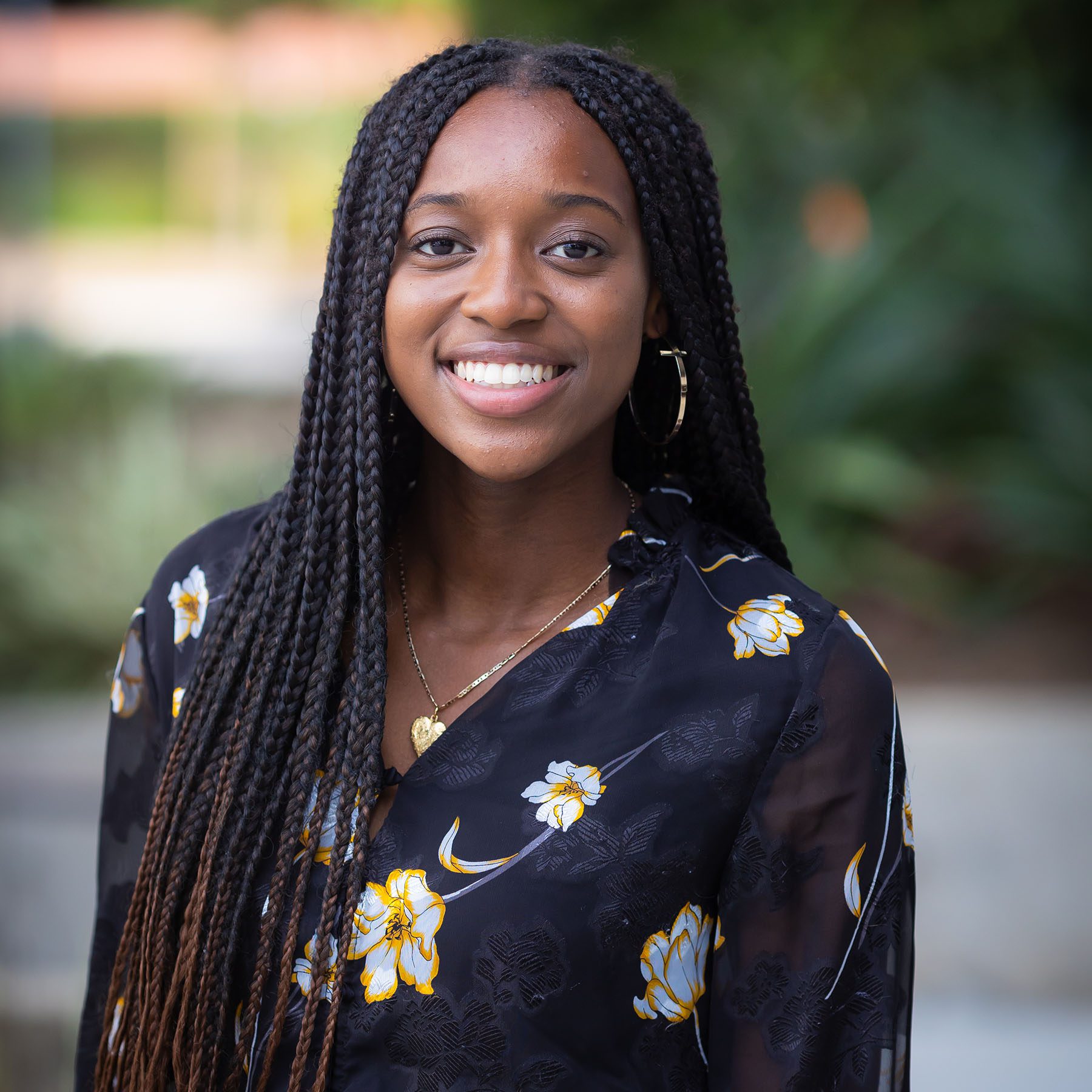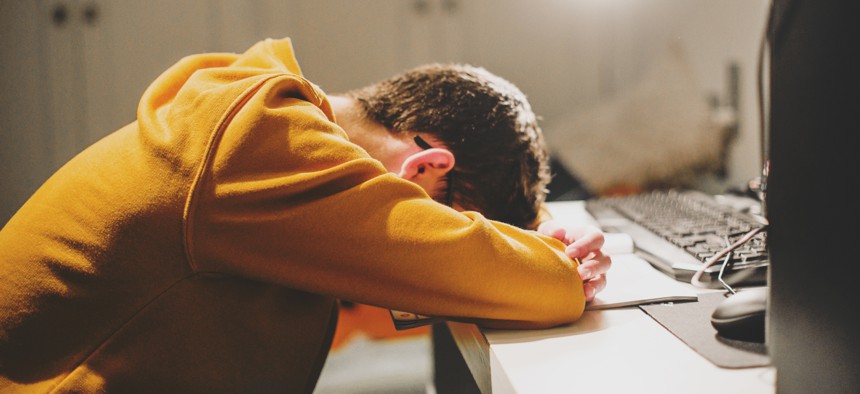Students Are Experiencing More Anxiety and Depression Symptoms during the Pandemic
Transitioning back to school for in-person learning in the fall wasn’t easy for students, especially for youth of color and LGBTQ+ youth.
Ekene Okolo enjoyed the flexibility of remote learning during the first year of the pandemic, so returning to in-person classes for her senior year at her San Diego high school in the fall took some adjusting. She’s juggled college applications and taking the SAT while playing varsity volleyball and interning for a politician.
All this has taken a toll.
“I am, like, very, very, very stressed,” she said. “I felt for a while [the issue] was mainly procrastination where I put off things because I was so tired of having to deal with the amount of things on my plate, but now I definitely feel anxiety a lot more, especially with college application season in full force, just knowing that the next four years of my future are hanging in the balance.”
Symptoms of anxiety and depression have doubled among young people worldwide during the pandemic, with 20 percent having anxiety symptoms and 25 percent experiencing depression symptoms, according to a new advisory from United States Surgeon General Vivek H. Murthy. Police killings of African Americans, hate crimes against Asian Americans, gun violence and political tensions in the United States have only added to the psychological distress of youth, the advisory noted.
On top of social injustice – a particular stressor for young people from marginalized communities – many youths struggle with the expectation that they be as productive as they were pre-pandemic now that schools have reopened, students and advocates told The 19th.
All this, and COVID-19 still has not gone away. The possibility of COVID-19 infecting them or their loved ones remains a real fear as coronavirus cases soar in children and more than 140,000 U.S. youth in the children have lost a caregiver to the virus.
Better access to counseling, discussions about emotional wellness in schools, time off for mental health and affirmation of their identities from family are some of the ways to give students the support they need right now, according to youth and experts. But, most of all, they say, it’s important that young people aren’t expected to snap back from a pandemic that’s still ongoing.
“It’s undoubtedly the case that many kids are still struggling,” said Mary Helen Immordino-Yang, a University of Southern California professor of education, psychology and neuroscience. “The pandemic isn’t over, and we still don’t have real assurance that we’re safe. And many kids were kind of lost during the pandemic when schools were not open. … Kids have developed ways to engage that don’t necessarily work well with in-person schooling, and it’s difficult to adapt back to the old way of doing things.”

Maya Henry, a sophomore at a Los Angeles high school, yearned to see her friends when school went remote. Now that in-person classes have resumed, however, she’s felt torn. A self-described extrovert, she enjoys having regular “human contact” again, she said. But, like Ekene, she’s found her much busier fall schedule to be overwhelming.
“I went from this world where my school day was three hours shorter,” she said. “I had fewer classes each day, and my teachers were very forgiving of late work, and with people just not being mentally ready to have their cameras on or to take tests, to suddenly back to 100 percent really quickly. I feel like my body and my mental health and just everything still hasn’t caught up. My anxiety is through the roof. My stress levels are so much worse than they were last year.”
To meet the needs of students struggling during the ongoing pandemic, innovations should be considered at the district, state or national level, Immordino-Yang said. That could mean offering young people more choice about how they attend school, including online options, hybrid models or shorter school days long-term. Traditionally, either elite students or struggling students placed in alternative education programs have had access to these modes of schooling, but it’s time that these options were expanded to youth generally, according to Immordino-Yang said. In 2021, legislators in Texas and California expanded distance learning and independent study options as demand for these alternatives surged during the pandemic.
A jam-packed school day isn’t the only contributor to Maya’s anxiety. She’s now fully vaccinated, but her fear of infection has not subsided.
“We came back to school, but we’re still wearing masks, and we’re getting tested once a week,” she said. “We’re in these tiny, tiny classrooms with, like, 35 kids, so I was really nervous about COVID, and I still am.”
Students who have suffered life-changing repercussions because of COVID, such as the loss of a loved one, housing or income, returned to school traumatized, Immordino-Yang said. These losses may have led to other problems, including higher rates of substance abuse or domestic violence among family members. And the fact that COVID-19 disproportionately affected the Black and Brown communities has made young people of color more vulnerable to mental health problems. That the pandemic coincided with a global movement for racial justice, catalyzed by the killings of Breonna Taylor, George Floyd and Ahmaud Arbery, has deeply affected 17-year-old Ekene, who is Black.

Moved to take action, she co-founded a youth organization with her sister called Black in PUSD to advocate for racial justice in the Poway Unified School District. But launching the organization exposes Ekene to disturbing experiences with racism that fellow students have had. The group, and the societal injustice that inspired her to form it, has also caused her to confront the pressure she feels being a Black student in a mostly White school district.
“Sometimes, I feel like I can’t really be my true self in school because I’m afraid that people will look at me differently and then have a negative perception of all Black people,” Ekene said. “I always feel the need to present myself in such a way that’s palatable to White people, just to make sure that I’m representing the Black race adequately, or just in a positive light. As an upperclassman, I have embraced my true identity a lot more, but there’s still a lot more work that I need to do.”
Youth from marginalized groups have faced unique mental health challenges during the pandemic and reported higher levels of psychological distress. While Black adolescents have experienced more symptoms of depression than their non-Black peers, 70 percent of LGBTQ+ youth have suffered “poor” mental health most of the time or always during the pandemic. According to the Trevor Project’s 2021 National Survey on LGBTQ Youth Mental Health, which details the experiences of nearly 35,000 LGBTQ teens and young adults in the United States, the family lives of these youth may be affecting their mental health. The survey found that only 1 in 3 respondents said their homes were LGBTQ-affirming.
Family members might not address transgender or nonbinary youth by the appropriate pronouns or allow them to express themselves authentically, said Amy Green, the Trevor Project’s vice president of research. Experiencing rejection and stigma inside their own homes worsens these young people’s mental health, already suffering due to an onslaught of discriminatory legislation introduced nationally during the pandemic, she said.
“The research shows so consistently that affirmation and support are some of the strongest protective factors for LGBTQ youth,” Green said. “One of the things we know about the COVID-19 pandemic was that for all youth, there were high rates of challenges with mental health, including anxiety and depression. But those who were already at higher risk — and LGBTQ youth are already four times more likely to consider suicide compared to their peers who are not LGBTQ — COVID-19 brought on even greater challenges.”
Maya, 15, came out as queer to her parents in fourth grade and is now a communications intern for the GSA Network, a youth-serving LGBTQ racial and gender justice organization. Although her parents have been supportive, she said, conflicts with them have increased during the pandemic.
“My parents have no problem with me being queer and being involved in GSA Network, but that doesn’t necessarily mean that they’re comfortable with it,” she said. “Maybe, they’re on a work call and I’m on a school call in the background talking about sexuality. And it was just kind of this added layer [of tension]. I never really had to think about how my parents would react to actually being confronted with discussions of LGBTQ+ identity because usually these discussions took place at school, but suddenly school was at home, and all these new discussions added stress to everyone.”
Now that she’s back on her high school campus, Maya worries about how being queer makes her vulnerable in society. She’s watched reports about gun violence, cyberbullying and weapons in school, and she sometimes wonders if she’ll be a target one day. “What if I’m the next person someone decides that they want to hurt in some form or the other?” she asked.
As students from marginalized communities manage their concerns about discrimination, hate, family and grades during a pandemic, they struggle to access the mental health care they need. The Trevor Project survey found that nearly half of survey respondents wanted counseling from a mental health professional but were unable to obtain it over the past year.
Expanding telehealth services, digital therapy and school-based health centers — primary care clinics on school campuses — are some of the ways to increase access to mental health care, according to Green. “But I think, as a country, we really need to invest in culturally competent mental health care and to make it accessible for all youth,” she said. “Schools are a great way to do that.”
Ensuring that schools have consistent funding to hire mental health care professionals is key, as hiring these workers only to fire them when COVID relief funds run out would be harmful, Immordino-Yang said. School districts have until fall 2024 to spend the latest multibillion-dollar installment of federal COVID relief from the American Rescue Plan Act, and Congress has directed school districts to spend at least some of this emergency funding on socioemotional learning, including mental health services for students. Immordino-Yang urges policymakers and school officials to invest in long-term changes, whether that’s dropping standardized tests for college admission or reevaluating how grades are earned in K-12 schools, shifts that some universities and school districts have already made during the pandemic.
“We really have a false meritocratic system where you have to do better than everybody else to do well, and you have to do it by yourself,” Immordino-Yang said. “You can’t do it with other people’s help; otherwise, it counts as cheating. So, we just have a whole narrative around what success is that is very incompatible with helping young people learn to get along with one another, engage in dialogue and seek out mental health supports when they need them.”
Although Ekene has the opportunity to take mental health days in her school district, she hesitates to do so because of the notion that people who need time off for their emotional well-being are weak, she said. In addition to districtwide mental health days, Ekene would appreciate more discussions about mental health in classrooms. Educators opening up about the fact that many people have mental health struggles would go a long way toward destigmatizing the issue, she said.
Maya simply would have appreciated her school easing students back into the daily grind of school instead of expecting students to immediately rebound from a year of distance learning. At her school, faculty members have discussed youth mental health, but she would like to see more action around the subject. That could mean giving students time off to tend to their mental health needs, she suggested, or giving them grace periods to turn in assignments.
It would help, she said, if “there was actually some tangible thing that was put in place, so that students actually saw that they were trying to make a smoother transition for us instead of them just saying, ‘Oh, we know this is hard. We know this is tough.’”







